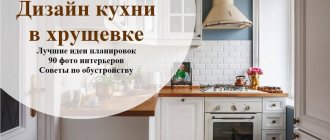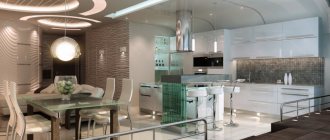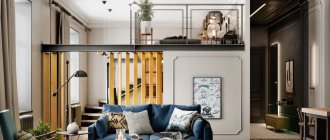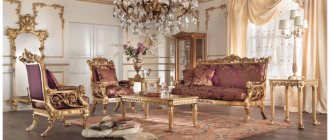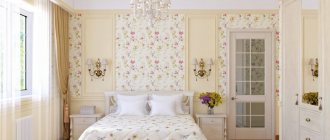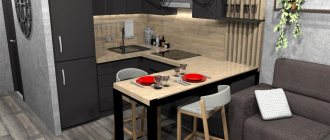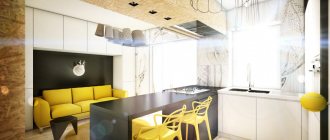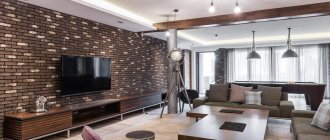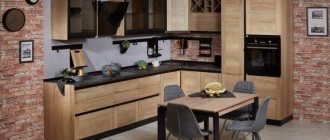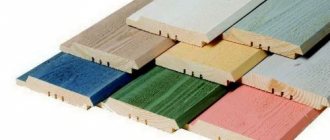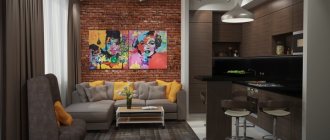Share with friends
Open plan living spaces have remained popular for many years. Often this allows you to visually expand the meager footage. And sometimes it is the individual whim of the owner. Whatever rooms you decide to combine, it is important that it is beautiful, functional and comfortable.
Many people think about the financial side of the issue, as well as how practical it is in each specific situation. Let's try to figure out how not to miss all aspects of such an experiment.
Which rooms are most reasonable to combine?
It’s unlikely that anyone will like to see their household members taking a bath; it will be problematic to try to fall asleep if, for example, your significant other needed to work at night, and sleeping with the lights on is not your thing. But no one would think of arguing that the kitchen and living room are the two parts of the apartment whose, so to speak, rhythms of life most coincide.
In the morning, you can type an article on your laptop, while another tenant is planning to fry pancakes. This will get your day off to a pleasant start rather than the other way around. But here another question arises. What design is allowed? Modern, Romanesque, Baroque, loft or industrial... Eyes run wild, and thoughts do not concentrate at all with such an abundance of choice...
But our answer is Scandinavia!
And that's why:
- Space for imagination and expanse of territory are two main tenets of the style.
- The restraint and severity of a chilling mentality in tandem with the courage inherent in the heroes of folk tales.
- Comfort is the head of everything, and light is the neck that sets its coordinates.
- Cost-effectiveness and ergonomics are what Scandi has been highly praised for more than once!
Well, let’s take a closer look at the plan for implementing a kitchen-living room in the Scandinavian sense. Let's start with each component separately.
When designing a place for preparing and eating food, and receiving guests, you need to focus on the following subtleties:
Pros and cons of decorating a kitchen-living room in a Scandinavian style
Like any option for organizing space, combining a kitchen and living room in a Scandinavian style has its pros and cons. Although, looking at the photo of the design of the kitchen-living room, I don’t want to think about any shortcomings.
Obvious advantages:
- creating a single room in which different functional areas can be competently and harmoniously arranged;
- in small apartments it becomes possible to organize a full-fledged dining area next to the kitchen work surfaces. This greatly simplifies the processes of preparing dishes and setting the table;
- Hosts can maintain full communication with guests while preparing food. Mothers can calmly do kitchen chores and not let children play in the living room out of their sight.
We cannot remain silent about some shortcomings:
- the spread of smells and sounds from the kitchen area cannot be limited. Some solution to the problem can be considered the installation of a powerful hood and the use of household appliances with low noise parameters;
- You will have to clean the kitchen area more often and more thoroughly, since it will be impossible to hide unaesthetic views. And it is unlikely that it will be possible to maintain such an ideal order as we see in the photo. If you like creative clutter, then in the living room it will look not like a cute mess, but like chaos.
The color of Scandinavian cuisine
As in other cases with Nordic housing concepts, the range is restrained. Grey, blue, white, beige, black in any variations. Note that the same quality corresponds to the decor as a whole.
Accessories, as usual, have the correct geometric shape and position. They are placed on the floor, tiny tables, walls alone or in a set with a lamp, which in the evening will sparkle with special colors and replenish the sun’s rays lost with sunset. Sometimes the ceiling is also decorated, also in combination with artificial lighting or as an independent unit.
It is useful to know that you should not use tension or hanging varieties, as they undermine the very idea of eco-style. Often a regular plastered and lightened ceiling is used, without any additions. However, the occasional inclusion of rebellious elements is highly appreciated!
A rug with an animal pattern or an embroidered maple leaf, colored but not colorful pillowcases, curtains the color of a young and juicy rose, blinds, Roman “curtains” - this and all sorts of accents you have the right to place in this field.
In addition, if you don’t want to end up with excessive coldness, diversify the environment with a countertop or other furniture in dark shades against the overall snow-white background.
Furniture
When selecting furniture for the kitchen-dining room and living room in the Scandinavian style, the following parameters are taken into account:
- simplicity of forms;
- single color of models - maximum two shades;
- practicality and ergonomics
Ideally, all models should be made from natural wood. It is best to choose furniture taking into account contrast. For example, white kitchen cabinets can be combined with wood-colored models, or use cabinets with glazed shelves. A light set or bar counter looks great on a wood-colored floor. This ensemble can be complemented by a light work surface or open wall shelves made in light colors.
The absence of handles on the facades of kitchen furniture is allowed. This minimalist approach brings the set closer to other furniture or dissolves it on a white background, which helps to visually increase the space. It is not customary to fill open shelves with kitchen utensils. They are intended for flowers and other decorative elements.
The main piece of furniture in a Scandinavian-style living-dining room is the dining table. It serves as a place for eating and effectively zones the space, separating the kitchen from the relaxation area. The wooden tabletop of the model will resonate well with other elements from the surrounding environment. Chairs in the kitchen should be accent pieces. This way they will complement the interior or will merge with it when the sun’s rays enter the room. Chairs must be placed under the table or bar counter, if available.
For the recreation area, it is advisable to choose upholstered wooden furniture upholstered in linen, leather or cotton. The number of models is minimal to preserve empty space. A classic example for a Nordic living room is a rectangular or U-shaped sofa with pillows, a coffee table, a carpet and a low wardrobe.
You can install a bookshelf or hang a wall clock on one of the walls. In addition to them, the living room interior is perfectly complemented by a pair of poufs, a vase or two or three pots with indoor plants. It is not for nothing that designers consider Scandinavia to be cozy minimalism, so residents should not neglect the beautiful little things that create a sense of comfort.
Sophistication of equipment
To prepare a variety of dishes you need a spacious area. The technical equipment is certainly rich. Of course, built-in equipment will be an ideal solution; here it is important not to skimp and understand what you cannot do without, or rather, what will make your life easier. Choose metallics, even something related to space. But bright colors, sea green or marsala, are not suitable in a particular situation. Leave it to other little things.
Careful selection of storage areas and devices
Don't be afraid to combine both accepted types: open and closed. After all, if all the shelves and racks reveal their contents, this will create “visual noise”, a feeling of chaos and disorder. Plus, who doesn't love to enjoy sweet little secrets in the nooks and crannies of their home? In addition, the vessels themselves, jars and flasks, boxes for containing products and devices will not get boring when they are original and special. Make them from an unusual texture, include among the standard objects a bag resembling the hat of a fairy-tale hero or a container with gifts from Santa Claus. Go for it!
Appearance
Modern Scandinavian cuisine looks harmonious in a collaboration of stone, natural or artificial, wood, which in turn can also be imitated, and ceramics. It is practical, calm and dynamic at the same time, can be linear, angular or parallel. Choose according to your needs. What can be said about the living room in the Celtic concept?
This room in our case is permeated with warmth and reminds us of frosty countries overnight. Minimalism, clear color schemes and warm, soft blankets on plain sofas are the first things that come to mind when talking about this room. What makes it functional and versatile? And what makes a chef's main refuge different?
Firstly, cooking ends at this stage. Nothing more than eating and talking over a cup of tea is allowed. Secondly, storage spaces take on a different appearance and content. Most of the shelves are closed, and the use of space and technology vary. In addition, this section of the apartment combines the qualities of a business office, a dining room, a reading room and, sometimes, a bedroom. This often happens in studios or other individual circumstances.
Finishing and materials used
Properly selected materials for finishing walls, floors, and ceilings will make the kitchen not only comfortable, but also warm, conducive to relaxation and pleasant cooking. Saturated colors are not excluded. These can be stools, tabletops, an apron. Scandinavian style is ideal for small kitchens and is similar to minimalism. Natural materials provide special comfort. When creating an aesthetic design, surface texture plays an important role.
Ceiling
The clearest expression of a Scandinavian interior can be achieved by decorating the ceiling with wide beams made of natural wood. This method of finishing borders on loft design. You can make it decorative with the help of original lighting fixtures, relief plaster, and special panels.
The ceilings of small kitchens in Khrushchev-era buildings must be white. You can apply paint or plaster to them. Stretch ceilings in light colors are also a suitable option, especially for problematic, uneven surfaces. Matte and glossy models will fit perfectly into any environment.
Installation of plasterboard ceilings will allow you to create original figures from spotlights. It is easy to hide communications between the base surface and the main plane. Slatted siding will look good in a kitchen of any size.
Walls
In Scandinavian design, frills will be inappropriate when decorating walls. The simplest possible finishing will create an excellent base. Various accessories and other interior items will highlight the neutral background. Smooth white walls can be diluted with brickwork or tiles with this imitation. For a studio kitchen, you can use this technique in different areas.
A simple and practical wall covering is plaster or paint. You can hide defects and uneven surfaces using non-woven wallpaper or fiberglass-based roll materials. Textured designs on Swedish-style walls will look good. You can make one wall next to the dining table, bar counter, or decorate all kitchen surfaces with moderate patterns as an accent wall.
Floor
It is better to choose a coating that is warm and natural. These can be massive wooden boards in light colors or bleached plank elements. Parquet and laminate with a single-strip pattern are also suitable. It is better to refuse linoleum, no matter what its color and pattern, otherwise it will immediately spoil the overall picture of the Scandinavian style.
An advantageous design technique is to combine floor coverings according to the zones of the room. You can put tiles or porcelain tiles next to the kitchen unit and work surfaces; the rest of the kitchen can be finished with wood. The baseboard must be high and must match the color of the wall.
We advise you to study - What the thickness of a parquet board can be in layers and in total and what it affects
Apron
The part of the wall above the worktop should have a special covering - an apron. An interior part that protects against splashes and stains during cooking can be made of various materials. The following options will fit perfectly into the Scandinavian style:
- "Boar" Tiles imitating brickwork. Thanks to the variety of shapes and design solutions, it can look different. The main distinguishing feature is the edges beveled at an angle of 45 degrees. Pairs perfectly with wallpaper and plaster.
- Wooden panels. They are resistant to high temperatures, have an original appearance, and are easy to clean. The material can be bleached, artificially aged, or photographically printed.
- Mosaic. The original design of the apron is suitable for both linear and corner kitchens. The color is white and all its shades. You can decorate the surface in monochrome style, with patterns or lay out a picture.
- Glass surfaces. White tempered glass wall panels are often used. Do not overload the decorative material with a complex print. If desired, you can add a light ornament or highlight it with a warm shade.
Zoning
The most important point is an unquestioningly clearly defined boundary. Without identifying zones according to their functions, you will end up with confusion, not cozy housing. This can be achieved by alternating or changing finishing materials, a certain arrangement of furniture, and, in fact, furniture. The most obvious delimiters are often wall and floor coverings.
It is clear that they can be seen with the naked eye! However, sometimes it is chosen to build small partitions made of glass, transparent or sparsely decorated, or bookshelves, which suggest placement on the sides of a sweeping entrance.
Another “highlight of the program” is a comfortable recreation area, pre-allocated by one of the above facilities. For example, a sofa bed will help save a couple of square meters, place books or candles nearby, everything that calms you down and a pleasant evening in the company of yourself, or someone more interesting, is guaranteed.
You don’t have to think that folding furniture is always cheap and cheerful. Choose a model with high-quality and beautiful design and even with an orthopedic mattress for a healthy sleep. You will understand that even such a piece of furniture has the ability to look respectable. A couple of chairs nearby are not prohibited, but be careful. Clutter is our worst enemy!
If we're talking about sleep, let's discuss cabinets. Since everything is clear with kitchen ones, what can we say about the same ones for clothes? Let's answer the pressing question of all fashionistas and mothers of large families... Yes, it is possible and even necessary to arrange a small dressing room! Neat, with shelves, containers, everything within moderate limits.
Remember we mentioned variety when it comes to storage? So, this will just add some spice to the general pot. Imagine, sometimes you can also place culinary delights prepared for the winter in the same way!
Color spectrum
The main color is white and all its shades. They can be warm or cold bleached. The color classic of the style is “snowy plain”. Blue, blue, gray, green, as well as isolated bright inclusions, harmonize perfectly with white. The following colors set the desired mood and allow you to play with the design:
- White. “The basis of Scandi”, the best way to fill a room with calm and spaciousness. It is possible to use all its shades (cream, milky, pearl). A matte tabletop with a marble pattern looks beautiful, as does furniture made of natural wood painted white.
- Grey. The main background is made pale gray. Any contrasting solutions are acceptable when one of the walls is decorated with dark wallpaper, decorated with paintings of snowy landscapes in white frames. Black accessories and household appliances look good.
- Green. Basic color schemes are pale shades of green (pistachio, mint). To liven up the interior, use rich green in accessories.
- Blue. Walls and floors are rarely finished. An aged blue set looks better against a white background. It shouldn't be an aggressive flashy color. The shade of the tables, chairs, and sofa is muted, closer to gray.
The final touch
Pay attention to details. Not only should they be stylized to match the decor in distributed areas, but well-chosen fittings and mechanisms will ensure the beauty and ergonomics of the entire environment rolled into one.
Imagine sitting down on a nice bar stool to have a snack, and it doesn’t rotate or even immediately falls apart due to poorly screwed components. Or that the entrance or adjacent door creaks and does not open well. Will you have a desire to relax and part with the burden of the past day in such conditions?
We think the answer is negative, and therefore it is better to take care of all sorts of little things in advance, place each figurine in its own appropriate location, so that tomorrow it does not fall on someone’s head and cause grief. Each participant in the actions in the kitchen-living room, which we are talking about now, should become an element of one big poem, an ode to light, comfort, practicality and safety!
What really unusual accessories are allowed to be used in our context? Consider decorating with firewood arranged in rows under the TV and deer antlers above it. The floor or tabletop can be lined with coins, not with motley mosaics made of ceramics and other available materials.
Sometimes, instead of transparent and frosted lamps, monochromatic colored lamps are chosen. Don't forget about the greens! Large or miniature, either will bring freshness and lightness. And, as always, naturalism is encouraged and quality artifacts are not off-limits.
We hope that the presented written work will be useful for you, if you do not consider yourself bold enough for your own grandiose ideas or, on the contrary, there are so many of them that they have merged together, without skillfully placed accents, we offer a selection of photos of Scandinavian kitchens that are easy to implement! We wish you good luck in your endeavors!
Key features of the style
The Scandinavian style in the decoration of the kitchen, as well as other rooms in the apartment, is distinguished by a number of main features:
- Good lighting through open windows and other sources of natural light. Lamps, chandeliers and sconces should not attract attention, since these are artificial elements and are not welcome when arranging the space.
- An abundance of light and pure shades. The primary colors are white and black, which set the tone and foundation. Pastel colors are used as additional ones - they will add softness and comfort. Also, we must not forget about natural wood. Tabletops in the set, floors, shelves and some decorative elements should be made from solid wood. The presence of metal inserts and additions is allowed - roof rails, appliances, dishes.
- Laconic forms. Neither the furniture nor the decoration are distinguished by the originality of the patterns. In a Scandinavian-style kitchen, carved cabinets, bulky tables with massive bases, and chairs with carved, curved backs are not appropriate. All details are deliberately simple, without unnecessary details or protrusions.
- Practicality of every element. Only necessary and necessary items are left. If a thing is present in the interior, then it must perform some task. They are also suitable for technology, which is why modern household devices are often purchased.
- When decorating the living room and dining room, preference is given to natural materials - wood or stone, fabrics and metal. Or their artificial analogues, safe and designed for long service.
